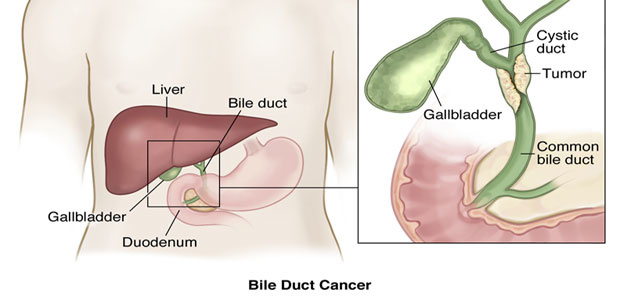
What is bile duct carcinoma?
Bile duct carcinoma originates from the bile duct, which includes malignant tumor located from hepatic hilar region to the lower end of common bile duct.
According to the position of tumor, bile duct carcinoma can be divided into two categories: intrahepatic bile duct carcinoma and extrahepatic bile duct carcinoma; furthermore, extrahepatic bile duct carcinoma can also be divided into upper bile duct carcinoma (bile duct carcinoma of porta hepatis), middle bile duct carcinoma and lower bile duct carcinoma, and among the three, bile duct carcinoma of porta hepatis is mostly seen.
What is the incidence rate of bile duct carcinoma?
Bile duct carcinoma is a kind of rarely seen cancer. There are about 2000-3000 new cases diagnosed each year and about 0.01%-0.46% among every 100,000 people would suffer from bile duct carcinoma.
And compared to other regions, the incidence rate of bile duct carcinoma in Southeast Asia is relatively high. The incidence rate would also increase as age goes by and the chances of incidence in male is slightly higher than that of female, while both of the incidence rates have an increase trend in recent years.
What are the causes of bile duct carcinoma?
The causes of bile duct carcinoma have not been defined yet, but it is believed that the following factors like chronic inflammation of biliary tract, calculus of bile duct or gallbladder stone, liver fluke, cystic malformation of the bile duct, may impose certain functions for triggering bile duct carcinoma.
Chronic inflammation of biliary tract: Long term chronic inflammation stimulation is the foundation of bile duct carcinoma occurrence, because it is found in clinical that all diseases related to bile duct carcinoma would lead to chronic inflammation of bile duct.
Calculus of bile duct and gallbladder stone: Based on the reports, 20-57% of bile duct carcinoma patients also suffer from gallstone or gallbladder stone. Therefore, it is believed that chronic inflammation of gallstone may be a carcinogenic agent.
Cystic malformation of bile duct (or congenital cholangiectasis): Congenital biliary duct cyst can easily turn into cancerous change. When pancreas becomes abnormal, pancreatic fluid shall reversely flow into bile duct and this causes cancerous of bile duct epithelium, which is the main cause for cancerous change.
Liver fluke (Chinese liver fluke): At Southeast Asia regions, people eat fresh fish which may cause some infections to the biliary tract, and fibrosis surrounded around the bile duct or bile duct proliferation. So liver fluke is one factor causing bile duct carcinoma.
What are the symptoms of bile duct carcinoma?
Jaundice: For bile duct carcinoma, the bile tract will be blocked by tumor and causes jaundice; jaundice would get worse gradually without pain-free for most of the cases; besides, the degree of jaundice is definitely related with the position of obstruct.
Abdominal pain: The upper abdomen would become uncomfortable when one’s eating. Hidden pain or dull pain occurs in the back; or angina in right upper side of the abdomen. These manifestations indicate that the nerves are being invaded.
Fever: Tumor obstructs bile duct and causes inflammation inside the bile duct, or furthermore causes fever, but which is rare.
Itch of skin: Itch may appear after or before the occurrence of jaundice. Itch of skin is caused by the changes of blood content and this stimulates the peripheral nerve of skin so that cause skin itches.
Other symptoms: loss of appetite, feel sick to greasy food, weakness, weight loss, nausea and vomiting or other nonspecific symptoms of the tumor. A minority will have symptoms of portal hypertension due to tumor invades to the portal vein.
What are the examination methods for bile duct cancer?
Laboratory check: It mainly examines liver disfunction due to obstructive jaundice, for example, if the bilirubin or alkaline phosphatase is increased.
Type B ultrasound: Type B ultrasound can display dilated bile duct or obstructive position, or even indicate the tumor out through repeated and careful examination.
MRCP examination: MRCP (which means Magnetic Resonance Cholangiopancreatograph), is one of the imaging test. It can largely display the full view of intrahepatic bile duct tree, show the position and scope of cancerous obstruction. Whether there is encroachment of liver parenchyma or liver metastasis, it is helpful for distinguishing duodenal papilla tumor and carcinoma of pancreas head.
CT scan: CT examination can accurately display cholangiectasis, the obstructed bile tract position and its scope. It also helps to define the identifications of lesion.
ERCP examination: ERCP (abbreviation of Encoscopic Retrograde Cholangio-Pancreatography) can get to know the general status of the whole bile tract, also collect the bile and the fallen-off bile duct carcinoma cells.
PTC examination: PTC, namely Percutaneous Transhepatic Cholangiography examination. As an accurate method to diagnose bile duct carcinoma, it can clearly display the distribution of intra or extra-hepatic bile duct tree, and show the obstructive position as well.
What are the traditional treatment methods for bile duct carcinoma?
Surgery
Chemotherapy
radiotherapy
Currently, surgery is still the most common treatment method for bile duct carcinoma.
Surgery includes the following types:
(1) Surgery for intrahepatic bile duct carcinoma;
(2) Surgery for bile duct carcinoma of porta hepatis;
(3) Surgery for middle bile duct carcinoma;
(4) Surgery for lower bile duct carcinoma.
Other treatments
What are the nursing methods for bile duct carcinoma?
Living nursing
Go to hospital for periodical review;
Life shall be regular;
Work shall be combined with rest reasonably;
Do some sports properly, for example: taking a walk, doing breathing exercise;
Diet nursing
Eat more those food that possess anti-cancer function, like buckwheat, sun-flower seed, tofu;
Eat more anti-infection and anti-cancer foods, like mung bean, rutabaga, bitter melon, lily;
Eat some food with the function of purgation, like fig, walnut, sesame etc.
The most suitable treatment method for bile duct carcinoma:
The multiple disciplines medical team composed by surgeons, pathologists, radio-oncologists and professional nurses, can provide patients with customized treatment plan, and greatly improve the therapeutic effects.
Due to insensitive of bile duct carcinoma to auxiliary radiotherapy and chemotherapy, which are the adjuvant post-surgery treatments for enhancing and securing the effects of surgery, more and more treatments are investigated to deal with bile duct cancer. These treatments include minimally invasive therapies, interventional therapy, immunotherapy, targeted therapy, traditional Chinese medicine and so on.
TCM has the function of regulating equilibrium and strengthening body’s resistance to fight against cancer, improving immunity. Modern Cancer Hospital Guangzhou combines TCM with other treatment technologies to integrate the advantages of TCM and improve the effect of treatment effectively.






 Telephone:
Telephone: